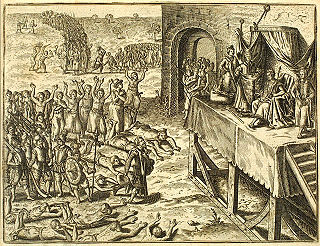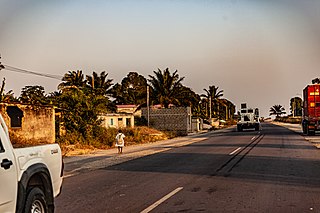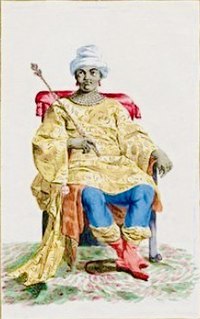
The Manikongo or Mwene Kongo was the title of the ruler of the Kingdom of Kongo, a kingdom that existed from the fourteenth to the nineteenth centuries and consisted of land in present-day Angola, Gabon, the Republic of the Congo, and the Democratic Republic of the Congo. The manikongo's seat of power was Mbanza Kongo, now the capital of Zaire Province in Angola. The manikongo appointed governors for the provinces of the Kingdom and received tribute from neighbouring subjects.

Álvaro I Nimi a Lukeni lua Mvemba was a Manikongo, or king of Kongo, from 1568 to 1587 and the founder of the Kwilu dynasty.

The Kingdom of Kongo was a kingdom located in central Africa in present-day northern Angola, the western portion of the Democratic Republic of the Congo, the Republic of the Congo as well as the southernmost part of Gabon. At its greatest extent it reached from the Atlantic Ocean in the west to the Kwango River in the east, and from the Congo River in the north to the Kwanza River in the south. The kingdom consisted of several core provinces ruled by the Manikongo, the Portuguese version of the Kongo title Mwene Kongo, meaning "lord or ruler of the Kongo kingdom", but its sphere of influence extended to neighbouring kingdoms, such as Ngoyo, Kakongo, Loango, Ndongo and Matamba, the latter two located in what is Angola today.

Kwilu, also known as the House of Kwilu, was a kanda or royal lineage of the Kingdom of Kongo.

Soyo is a city, with a population of 200,920, and a municipality, with a population of 227,175, located in the province of Zaire in Angola, at the mouth of the Congo river. Soyo recently became the largest oil-producing region in the country, with an estimate of 1,200,000 barrels per day (190,000 m3/d).
The Bemba belong to a large group of Bantu peoples mainly in the Northern, Luapula, Muchinga, the Northern part of Central Province. The Bantu also belong to the Copperbelt Provinces of Zambia who trace their origins to the Luba and Lunda states of the upper Congo basin called Kola, in what became Katanga Province in southern Democratic Republic of the Congo. The Bemba entered modern-day Zambia through crossing the Luapula River at Chipya in the Senior Chief Matanda's Chiefdom in Mansa _Luapula Province and that Chief Matanda and his Ushi people were the first to come into Zambia by the year 1328 from Kola. The collection of ethnicities known as Bemba have a ruling class called Abena Ng'andu. This clan traces its ancestry to Mbemba Nshinga who ruled Kongo from 1509-1543. Mbemba was called King Afonso l by the Portuguese whom he hosted in his kingdom for many years. They are one of the larger ethnic groups in Zambia. (A few other ethnic groups in the Northern, Luapula, and Copperbelt provinces of Zambia speak languages that are similar to Bemba but are not necessarily the same. For example, although the Lamba have the same roots as the Bemba, they never relied on the Bemba aristocracy for leadership. Indeed the Bemba people are not strictly indigenous to the Copperbelt Province, having rejoined the Lamba in that province in the 1930s when they went their in large numbers in search of employment opportunities brought about by the opening of large scale copper mines. In contrast members of the Bisa royal family are almost all descendants of Chitimukulu, as are many members of the Swaka and Lala aristocracies. Bemba history is a major historical phenomenon in the development of chieftainship in a large and culturally homogeneous region of central Africa.
Nsundi was a province of the old Kingdom of Kongo. Its capital was located on the Inkisi River, near the present-day village of Mbanza Nsundi in Democratic Republic of Congo.

Nkumbi-a-Mpudi Diogo I was manikongo in 1545–1561. King Diogo was the grandson of king Afonso I of Kongo and won the throne after overthrowing his uncle Pedro Nkanga a Mvemba and forcing him to take refuge in a church in São Salvador. Diogo's early struggles are documented in a legal inquest he conducted in 1550 into a plot against him launched by the former king. In 1555, the king cut all ties with the Portuguese whom he saw as meddlesome and a threat to the kingdom and expelled all 70 Portuguese inhabitants from the kingdom.
Mvemba a Nzinga, Nzinga Mbemba or Funsu Nzinga Mvemba, also known as King Afonso I, was the sixth ruler of the Kingdom of Kongo from the Lukeni kanda dynasty and ruled in the first half of the 16th century. He reigned over the Kongo Empire from 1509 to late 1542 or 1543.
Lukeni lua Nimi was the traditional founder of the Lukeni kanda dynasty, first king of Kongo and founder of the Kingdom of Kongo Dia Ntotila. The name Nimi a Lukeni appeared in later oral traditions and some modern historians, notably Jean Cuvelier, popularized it. He conquered the kingdom of Mwene.

Nzinga-a-Nkuwu João I né Nzinga-a-Nkuwu, was the 5th ManiKongo of the Kingdom of Kongo between 1470 and 1509. He voluntarily converted to Roman Catholicism. He was baptized on 3 May 1491 and took the Christian name of João. Soon after, ManiKongo Nzinga-a-Nkuwu João I abandoned the new faith for a number of reasons, one of them being the Roman Catholic Church requirement of monogamy. Politically, the king could not afford to abandon polygamy and embrace monogamy, a cultural shift that the king could not contemplate as power in Kongo was elective, rather than hereditary as in Europe. Kongo culture followed a Matrilineality structure, where the elder son of the king is not automatically the next king.
Pedro I Nkanga a Mvemba was manikongo of the Kingdom of Kongo from 1543 until being deposed in 1545.
Pedro II Nkanga a Mvika was a ruler of the kingdom of Kongo during the kingdom's first conflict with the Portuguese colony of Angola. He was the founder of the royal House of Nsundi and could trace his descent to one of Afonso I's daughters.
Afonso II Mpemba a Nzinga was a ruler of the Kingdom of Kongo in 1561.
Nanga of Kongo was the second ruler or manikongo of the Central African kingdom of Kongo, from the Lukeni kanda dynasty. He was born around 1381 and the dates and events of his reign are not exact, but he ruled from around 1420 to around 1435, when he died. It is known that he was a cousin of the kingdom's founder, Lukeni lua Nimi.
Nlaza of Kongo was a manikongo from the Lukeni kanda dynasty and the 3rd ruler of the Central African kingdom of Kongo in the early 15th century between c. 1435 and c. 1450. Little is known about him or his reign other than he was one of two cousins of Kongo's founder, Lukeni lua Nimi.
Garcia I Mvemba a Nkanga was a manikongo of Kongo whom ruled from April 27, 1624 to March 7, 1626.

The Kilukeni were members of the Lukeni kanda or House of Kilukeni, the ruling dynasty of the Kingdom of Kongo from its inception in the late 14th century until the 1567 with the rise of the House of Kwilu. The Kilukeni were springboard for most of the major factions that battled for control of Kongo during its civil war.

Mbanza-Kongo, is the capital of Angola's northwestern Zaire Province with a population of 148,000 (2014). Mbanza Kongo was founded some time before the arrival of the Portuguese in 1483 and was the capital of the Kilukeni dynasty ruling at that time. The site was temporarily abandoned during civil wars in the 17th century. It lies close to Angola's border with the Democratic Republic of the Congo. It is located at around 6°16′0″S14°15′0″E and sits on top of an impressive flat-topped mountain, sometimes called Mongo a Kaila because recent legends recall that the king created the clans of the kingdom and sent them out from there. In the valley to the south runs the Luezi River. In 2017, Mbanza Kongo was declared as a UNESCO World Heritage Site.







